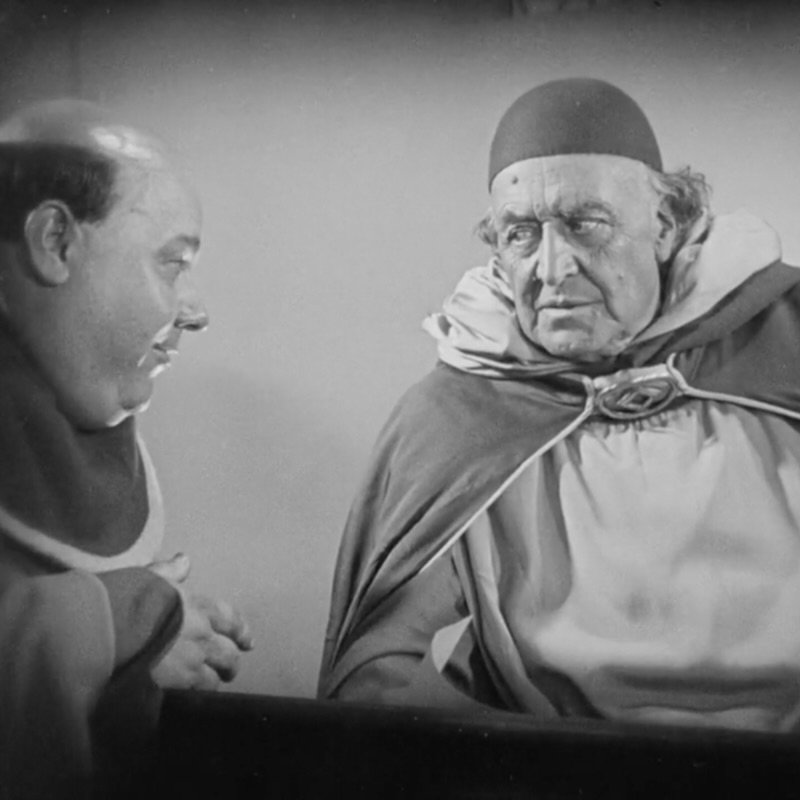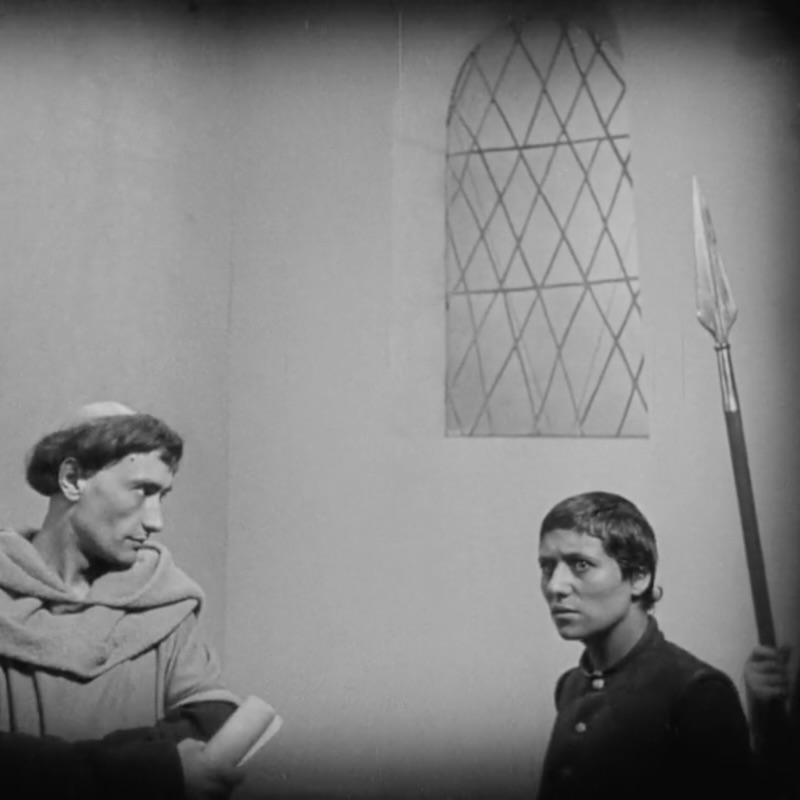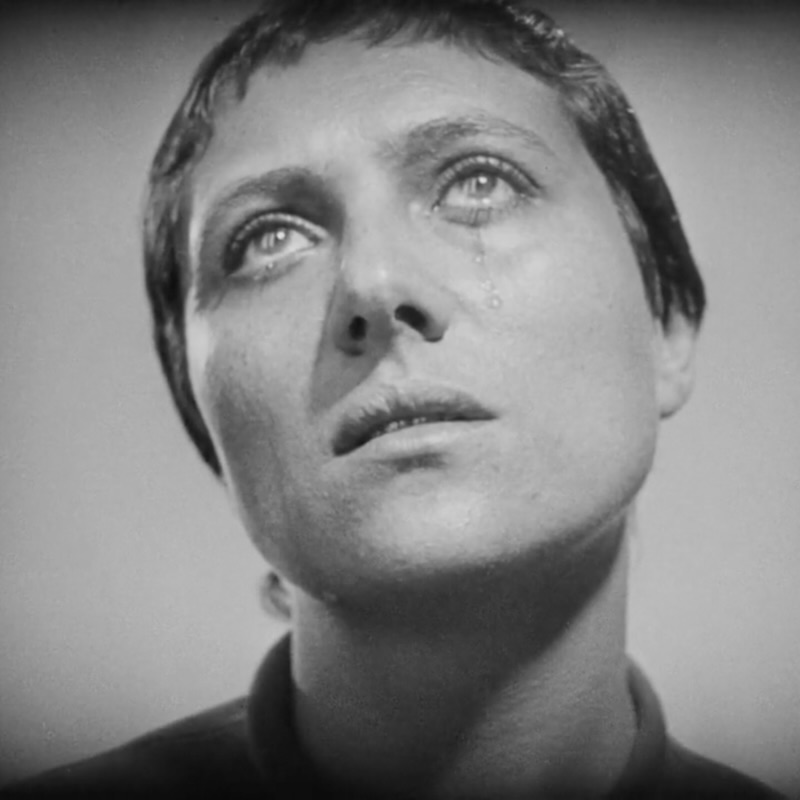By Tom Plovie
Reportage
La passion de Jeanne d’Arc
Carl Theodor Dreyer (1928)
& The Orlando Consort
(NL)
gezien te Gent in De Bijloke op 06-10-2022
Vijf mannen staan naast elkaar in zwart kostuum, oortjes in, het gezicht zwak belicht, enkele laptopschermen voor hen en een groot projectiedoek boven het podium. Dat is de setting van een uitzonderlijk filmconcert. Ik ben getuige van de stillefilmklassieker ‘La passion de Jeanne d’Arc’ uit 1928 waarbij het oude muziekensemble The Orlando Consort (U.K.) live muziek brengt. Het is een combinatie waar ik erg benieuwd naar ben. Veel vragen gaan door mijn hoofd: ‘Hoe zal ik zo’n oude film beleven?’, ‘Gaat het verhaal niet te traag verlopen?’, ‘Welk effect zal de muziek erop hebben?’, ‘Zal ik meer te weten komen over Jeanne d’Arc?’, etc. Dat deze avond mij zou triggeren wist ik op voorhand. Wat ik niet wist, is dat ze zou resulteren in een intrigerende ervaring.
De film is van de hand van de Deense regisseur Carl Theodor Dreyer (1889-1968) en ging in 1928 in première te Parijs. Hoewel de film door kenners meteen als meesterwerk werd erkend, bleek zij een commerciële flop. Tot overmaat van ramp gingen de negatieven van de film verloren in een brand in de jaren 30. Het duurde tot 1981 vooraleer de cultstatus van de film aan een opmars begon. Er werd toen een intacte versie gevonden in een Noors centrum voor geestelijke gezondheidszorg – oh, ironie: wetende dat actrice Renée Maria Falconetti (die Jeanne d’Arc vertolkt) zelf haar ganse leven met mentale problemen te kampen had… Momenteel wordt ‘La passion de Jeanne d’Arc’ beschouwd als één van de belangrijkste films uit het tijdperk van de stomme film.
Het meest in het oog springende van de film is het veelvuldig gebruik van close-ups en het experiment met bijzondere camerastandpunten. Zo groef Dreyer vaak putten om het juiste kikvorsperspectief te kunnen capteren. Inhoudelijk focust de film op het gedocumenteerde proces van Jeanne d’Arc uit 1431: haar berechting, gevangenschap, marteling en tot slot de terechtstelling op de brandstapel als finale climax. Zoals de titel reeds aangeeft, zijn er onlosmakelijk linken met de passie van Christus: de foltering, de kroon, het bespotten door soldaten, de eigenlijke executie, de inkeer van het volk nadat ‘het offer’ is volbracht,… Weinig wordt aan het toeval overgelaten: de symboliek in de film is omnipresent.
Tussen de scènes door verschijnen er zwarte beelden met de originele Deense tekst die in het Engels werd vertaald. Al van in het begin wordt duidelijk gemaakt hoe de verslaggeving van het proces, letterlijk met vraag en antwoord, een mens van vlees en bloed wil laten zien. Of hoe een jonge vrouw van amper 19 (Falconetti was in 1928 al 35 jaar) moest opboksen tegen oude kerkgeleerden en een bloeddorstige jury. Tijdens het proces valt het mij op dat Jeanne nooit een goed antwoord had kunnen geven. Wat antwoord je op de vraag of de aartsengel Michaël een man of een vrouw is, of hij/zij vleugels heeft of lang haar? Vaak was de respons van de jury een briesende ‘Blasfemie!’. Viel het anders te verwachten?
Omdat Jeanne weigert te bekennen dat de vele stemmen en visioenen die ze had van de Duivel zijn, komt de folterkamer in beeld. Het is één van de weinige ruimtes die volledig en gestoffeerd zichtbaar zijn. Een rad met pinnen krijgt snelheid en de suggestie eronder te liggen is voldoende voor Jeanne om flauw te vallen. De enige fysieke ingreep die we te zien krijgen, is uiteindelijk een aderlating. ‘Niet te veel!’ snauwt de bisschop, want ja: het proces heeft hem al veel gekost en haar (onvermijdelijke?) dood mag niet veroorzaakt worden door een banale ‘medische’ ingreep (…). Finaal gaat het richting de brandstapel, nadat Jeanne besluit om een valse (afgedwongen) bekentenis alsnog in te trekken. De foltering aan de staak wordt enkel getoond via de uiterst expressie blik van Falconetti, het brandend hout onderaan de stapel en de jammerende blikken van de getuigen. Na de doodstrijd richt de aanschouwende massa zich plots tot de machthebbers en verwijten hen een heilige te hebben gedood! Prompt wordt er langs alle kanten met een goedendag op het volk geklopt. Een ijzingwekkend slot.
Er valt nog zoveel meer te vertellen over de film maar de live muziek van The Orlando Consort verdient evenveel aandacht. Belangrijk om daarbij van start te gaan is het feit dat alle gekozen muziek uit de korte periode komt waarin Jeanne d’Arc leefde: composities daterende tussen 1412 en 1431 (de middeleeuwen). Een opmerkelijke keuze, maar naar mijn gevoel zeker de juiste. Ook het feit dat er enkel a capella werd gezongen voelt correct: gezien het net stemmen zijn (die van God, de aartsengel Michaël of dan toch de duivel?) die Jeanne d’Arc tot acties heeft gebracht. Met nauwgezette precisie werd gezocht naar passende fragmenten op de bijhorende scènes.
Zo horen we het ‘Ave verum corpus’ (‘gegroet waarachtig lichaam’) van Johannes Reson (1425-35) tijdens de scène van het aderlaten, hetgeen een verwijzing vormt naar de soldaat die Christus’ lichaam met een speer doorboorde. Wanneer de Engelse soldaten Jeanne belachelijk maken, door haar een kroon van riet te laten dragen en een pijl als scepter te geven, zingt The Orlando Consort het ‘Agincourt Carol’: een link met de beroemde Engelse overwinning in 1415. Oh, wat voelen de Engelsen zich plots groot! Om Jeanne tot een bekentenis te verleiden wordt haar het sacrament beloofd (want de Kerk is genadig!) en een tijdelijk altaar voor de mis wordt gebouwd. Op het moment dat Jeanne weigert de verklaring te ondertekenen wordt de mis prompt afgebroken en het altaar ontmanteld. Synchroon hoort het publiek Gilles Binchois’ ‘Deo Gracias’: het signaal voor het einde van een mis. Het zijn allemaal subtiele keuzes en beslissingen die, zelfs zonder de expliciete kennis ervan te hebben, zeker werken op het getoonde filmmateriaal.
Een laatste voorbeeld: Jeanne wordt naar het schavot geleid. We zien ondertussen een oude vrouw die haar water aanbiedt. Ze krijgt een kruis om zich aan vast te klampen. Er landen witte duiven op het dak van het gebouw achter haar. Ondertussen wordt het ‘Veni Creator spiritus’ (‘Kom Schepper, Geest, daal tot ons neer’) gezongen. Het moet ons herinneren aan het beleg van Orléans in 1429: de eerste grote Franse overwinning op de Engelsen onder leiding van Jeanne d’Arc. Dit nummer zou toen in een mars met het leger en priesters gezongen zijn geweest. Nu ze geofferd wordt, klinkt het lied als een beklijvende en verre herinnering. Wat een precisiewerk om deze muzikale puzzel te leggen!
Na het concert en het zien van de film blijven er vragen door mijn hoofd spoken, maar de eerder gestelde zijn beantwoord. Ik vond het een bijzondere ervaring om zo’n oude film in volle glorie te zien: op een groot scherm, in een zaal én met prachtig vertolkte live muziek. Ging de film te traag? Misschien wel, maar het verplichtte mij ook om net die traagheid te omarmen en met ‘een andere bril’ te kijken. Verfrissend. En wat met die overdreven mimieken en de vele close-ups? Het liet mij nadenken over de evolutie van film doorheen de decennia. En hoewel de vorm ervan enorm is getransformeerd blijf het, in essentie, gaan over emoties overbrengen. Zelfs met een minimum aan attributen, decor of tekst is het letterlijk zien van twijfel, angst, moedeloosheid, boosheid, wanhoop, etc. voldoende om dat doel te bereiken – ook al zijn we bijna honderd jaar verder. Tot slot: heb ik veel bijgeleerd over Jeanne d’Arc? Misschien niet meteen door het zien van de film (gezien de focus op het proces), maar die avond heeft me er wél toe aangezet om opzoekwerk te verrichten en dit artikel te schrijven. Hoe dan ook een verrijkende ervaring.


The Orlando Consort:
Matthew Venner (countertenor)
Mark Dobell (tenor)
Angus Smith (tenor)
Donald Greig (baritone)
Robert Macdonald (bass)
La passion de Jeanne d’Arc
Carl Theodor Dreyer (1928)
& The Orlando Consort
(NL)
as seen at Gent in De Bijloke on 06-10-2022
/. English version
Five men stand beside each other in black suits. They’re wearing little plugged-in earphones. Their faces are slightly lit. Some laptop screens are in front of them and a big projection screen hangs above the scene. This is the setting of an exceptional film concert. I witnessed the classic silent movie ‘La passion de Jeanne d’Arc’ made in 1928, supported by live music from The Orlando Consort (United Kingdom). It’s a combination that I’m quite interested in. I have a lot of questions that come to mind:‘How will I experience such an old movie?’, ‘Will the story not go to slow?’, ‘How much impact will the music have?’, ‘May I find out more about Joan of Arc?’ etc. That this evening would trigger me, I knew beforehand. What I wasn’t aware of was that it would be a really fascinating experience.
The film was directed by Danish director Carl Theodor Dreyer (1889-1968) and premiered in Paris in 1928. Even though the movie was recognised as a masterpiece by connoisseurs, it turned out to be a commercial flop. To make things worse, the movie’s negatives were lost in a fire in the 1930s. It was not until 1981 that the film began to progress in its cult status. An intact version was then found in a mental health centre in Norway – oh, irony! Knowing that actress Renée Maria Falconetti (who plays Joan of Arc) has been dealing with mental illness throughout her life… Currently, ‘La Passion de Jeanne d’Arc’ is considered to be one of the most important films of the era of silent cinema.
The most striking feature of the movie is the frequent use of close-ups and the experimentation with special camera views. For example: Dreyer often dug wells to be able to capture the right worm’s-eye view. The film focuses on the documented trial of Joan of Arc from 1431: her trial, her imprisonment, torture and finally the execution at the stake as a final climax. As the title already states, the film is inextricably linked to the passion of Christ. There is torture, the crown, the mockery of soldiers, the execution, the repentance of the people after the ‘sacrifice’ has been carried out. Nothing remains to chance: the symbolism of the film is omnipresent.
Between the scenes, black screens appear with the original Danish text which has been translated in English. At the beginning it is clearly indicated how the report of the process, literally with question and answer, wants to show a human being of flesh and blood. Or how a young woman of barely 19 (Falconetti had already reached the age of 35 in 1928) had to fight against old church scholars and a blood thirsty jury. As the process unfolds, it strikes me that Joan would never have been able to give a good answer. How do you answer the question of whether the archangel Michael is a man or a woman, whether he/she has wings or long hair? Often, the jury’s response was a brutal ‘Blasphemy!’. Were we expecting something different?
Because Joan refuses to admit that the many voices and visions come from the devil, the torture chamber is depicted. It is one of the rare spaces that can be seen in plain sight. A wheel with pins takes on speed and the suggestion to lie down below is sufficient for Joan to pass out. The only visible physical procedure is forced bleeding. ‘Not too much!’ the bishop cries. Because the process has cost him dearly and a (inevitable) death must not be caused by a banal ‘medical’ intervention (…). Finally, they go to the woodpyle after Jeanne decides to withdraw a fake (forced) confession. The torture at the stake is shown only by the extremely expressive gaze of Falconetti, the burning wood on the stack and the moaning glances of the witnesses. After the death struggle, the spectators suddenly turn against the rulers and reproach them for having killed a true Saint! Prompt people are beaten from every side with a ‘goedendag’ (a medieval weapon). What a horrific end!
There’s so much more to say about the movie, but the live music of The Orlando Consort merits equal attention. It is important that we start here: the fact that all the music chosen comes from the brief period in which Joan of Arc actually lived. We are speaking of compositions from 1412 to 1431 (Middle Ages). A remarkable choice, but I think certainly the right one. Moreover, the fact that only a capella has been sung appears correct.
Because these are voices (those of God, the archangel Michael or the devil?) which Joan of Arc set in motion. With meticulous precision, research has been made for suitable fragments on accompanying scenes.
We hear the ‘Ave verum corpus’ (‘Hail, true Body, born’) from John Reson (1425-35) during the scene of the bloodletting. This refers to the soldier who pierced the body of Christ with a spear. When English soldiers make Joan ridiculous, wearing a crown of reeds and giving her an arrow as a scepter, The Orlando Consort sings the ‘Agincourt Carol’: a link with the famous English victory in 1415. Oh, how the Englishmen suddenly feel grandiose! To seduce Jeanne into a confession, she’s promised the sacrament (because the Church is merciful!) and a temporary altar is built before Mass. When Joan refuses to sign the declaration, the Mass abruptly stops and the altar is taken apart. At the same time, the audience hear Gilles Binchois ‘Deo Gracias’: the signal before the end of a Mass. These are all subtle choices and decisions that, even without explicit knowledge, certainly work on the cinematographic material presented.
A final example: Joan goes to the scaffold. We see an elderly woman giving her water. She gets a cross to cling to. White pigeons swoop onto the roof of the building behind her. Meanwhile, ‘Veni Creator Spiritus’ (‘Come, Holy Ghost, Creator, come’) is sung. It should remind us to the siege of Orléans in 1429: the first major French victory over the British under the direction of Joan of Arc. This chant would have been sung on the march with the army and the priests. Now that Joan gets sacrificed, the song sounds as a distant and emotional memory. So much precision to create this musical puzzle!
After the concert and the movie, the questions keep coming to my mind. But the previous questions have all been answered. I thought it was an exceptional experience to watch such an old movie in all its splendour: on a big screen, in a concert hall and with live music beautifully performed. Was it too slow? Maybe, but it also forced me to embrace this inertia and to look at it ‘with another pair of glasses’. Quite refreshing. What about those over-the-top mimics and a lot of close-ups? This made me reflect on how cinema has evolved over the decades. And although its form has been significantly changed, its basis is still the transmission of emotions. Even with a minimum of attributes, scenery or text I’ve literally seen doubt, fear, discouragement, anger, despair, etc. It achieved that goal, even if it’s almost one hundred years ago. And have I learned a lot about Joan of Arc? Perhaps not immediately upon seeing the movie (because of the focus on the trial), but that night I got involved in research to write this article. It was a rewarding experience.


The Orlando Consort:
Matthew Venner (countertenor)
Mark Dobell (tenor)
Angus Smith (tenor)
Donald Greig (baritone)
Robert Macdonald (bass)
Tags
Reportage
Carl Theodor Dreyer
La passion de Jeanne d’Arc
Scandinavian Cinema
Denmark
The Orlando Consort
Classical Music
Author
Tom Plovie - Lokeren, 06 October 2022
Sources
Trailer: Chiltern Arts Festival 2018: The Orlando Consort – Voices Appeared- The Orlando Consort
